Being the worry-wart that I am, I worry about other boats not seeing our anchored boat and accidentally running into us. Having a dark hull and dark canvas certainly doesn’t help. It’s much easier seeing a white hull in the dark than a dark hull. And having anchored in lots of places where the after dark no wake requirements aren’t as stringent as in US waters, there’s always the possibility of a fishing boat flying home ramming into us.
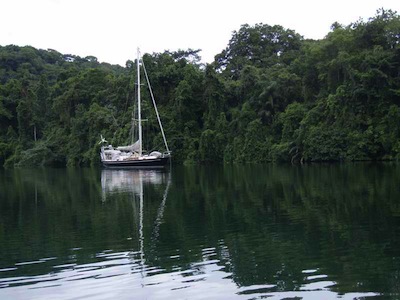
When we were still in the “pre-cruising” stage – we spent a month in the Keys. David instructed me to “turn everything off” on the electrical panel as we left the boat to have dinner. I did exactly as he said and turned off every single switch … including the one that said Anchor Light. Duh! I didn’t even look, just followed instructions. After dinner, in the pitch dark, no moon, we returned to the boat. The wind had picked up ahead of a cold front and we were damp and miserable in our little 8′ dinghy. We dinghied to where the boat should be, no boat. We continued … and continued. Finally David said “we should be WAY past the boat by now, you did leave the anchor light on, right?” …. oops … we finally found it. In the dark, we had dinghied right past and never seen our own hull! Yikes!
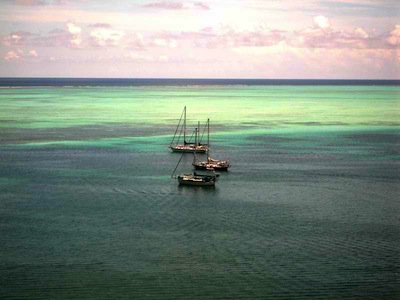
The prior owner of our boat had done a lot of research on anchor lights and decided to place our anchor light, not at the top of the mast, but on the radar dome pole, which we have since modified to be an arch. Our anchor light is on a pole coming up from the radar arch. We believe it complies with anchor light requirements AND it’s closer to water level, making it easier for a zooming fishing boat to spot – often they’re not looking up. And in some anchorages, locals don’t expect a sailboat to be anchored, so they don’t look up. In our experience, anchor lights at the top of a mast often blend in with the stars … or city background … making them much more difficult to see.
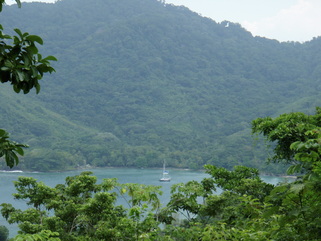
Are we “legal”? Who knows… our prior owner was convinced we are. We’ve been boarded by the US Coast Guard and the Colombian Coast Guard and no one has ever said we’re not legal. But to say that US anchor light requirements for recreational boats for cruising folks are ambiguous is an huge understatement!
Then add in factors if you’re planning on cruising away from US waters and the decisions become even more complicated. This is not a post so much on the legalities of anchor light placement, but rather the practicalities and realities. If you want the “real thing” just go read the “rules” from the US Coast Guard or the Federal Requirements for Recreational Boats (scroll down for links and reprints of both USCG Rule 30 and the Fed Anchored Vessel requirements).
After being concerned many nights sitting in the cockpit watching boats moving around us, we’ve changed our anchor light configuration just a bit.
1. We changed our our original anchor light to an LED which automatically turns on at dusk and shuts off at daybreak … of course, this assumes we leave the breaker ON to the Anchor Light, but I learned my lesson years ago! This means, we leave the breaker on all the time and never have to remember to turn on the anchor light when we leave the boat when it’s still light for sunsetters aboard another boat. Very convenient!
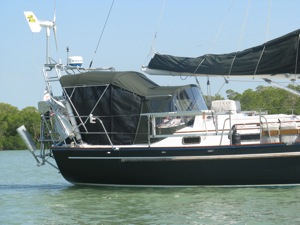
2. The LED light also has the distinct advantage of burning far fewer amps than the original anchor light, which makes my amp ogre husband much happier.

3. We added a solar light (regular cheapo yard light) on the bow pulpit. This illuminates the bow so hopefully boats speeding around in the dark can see both the front and the back of the boat. Of course, it has to be replaced every year, but it’s cheap, so who cares.
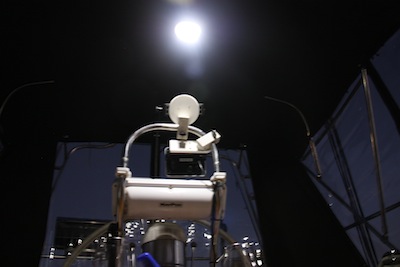
4. We use a LumiQuest SoLite solar powered portable light for our cockpit light, replacing our Davis Mega-Light which we also liked. The SoLite has the advantage of being inexpensive, recharges itself with solar daily and it comes on automatically at dusk & shuts off at daylight. When we’re off the boat, it comes on automatically and provides a night light for us to see to unlock the companionway, plus it provides more illumination so hopefully our dark hull boat is easier to see. Click here for a post I wrote when we added the SoLite cockpit light last winter.
5. If we’re in the cockpit and in doubt whether a boat sees us … as last winter in the fog in Factory Bay, Marco Island, we switch on the spreader lights to brightly illuminate the entire deck, which IS white, and not dark like the rest of the boat. I’m convinced the dinner cruise boat had to alter course to miss us on his way back to the dock … and we were IN the anchorage, he was just cutting across and didn’t expect us to be anchored there.

Do you have a different night time lighting arrangement that works for you? Please leave a comment and share. Oh, and if you want to read the “rules” scroll down! Cheers — Jan
************************
US Coast Guard Regs: Rule 30 – Anchored Vessels and Vessels Aground
(a) A vessel at anchor shall exhibit where it can best be seen: 
(i) in the fore part, an all-round white light or one ball;
(ii) at or near the stern and at a lower level than the light prescribed in subparagraph (i), an all-round white light.
(b) A vessel of less than 50 meters (164 feet) in length may exhibit an all-round white light where it can best be seen instead of the lights prescribed in paragraph (a) of this Rule. 
(c) A vessel at anchor may , and a vessel of 100 meters and more in length shall, also use the available working or equivalent lights to illuminate her decks. 
(d) A vessel aground shall exhibit the lights prescribed in paragraph (a) or (b) of this Rule and in addition, if practicable, where they can best be seen; 
(i) two all-round red lights in a vertical line;
(ii) three balls in a vertical line.
(e) A vessel of less than 7 meters (almost 22 feet) in length, when at anchor not in or near a narrow channel, fairway or where other vessels normally navigate, shall not be required to exhibit the shape prescribed in paragraphs (a) and (b) of this Rule.
(f) A vessel of less than 12 meters (39 feet) in length, when aground, shall not be required to exhibit the lights or shapes prescribed in subparagraphs (d)(i) and (ii) of this Rule.
(g) A vessel of less than 20 meters (66 feet) in length, when at anchor in a special anchorage area designated by the Secretary, shall not be required to exhibit the anchor lights and shapes required by this Rule.
Ed Comment: Please ignore Rule 30g where it states that if you’re in a “designated anchorage” and you’re under 66 feet, you don’t need an anchor light… really? We ALWAYS have our anchor light on, even in designated anchorages. Craziness is rampant!
Anchored Vessels Federal Requirements for Recreational Vessels
Power-driven vessels and sailing vessels at anchor must display anchor lights. An anchor light for a vessel less than 50 meters in length is an all-around white light visible for 2 miles exhibited where it can best be seen (see Figure 7). Also vessels at anchor shall exhibit forward where best seen, a ball shape (see Figure 8).

Anchor lights are not required on vessels less than 20 meters. Anchored in special anchorages in Inland Waters designated by the Secretary of Transportation. (Ed Note: Bah humbug, we’ll have ours on anyway!)
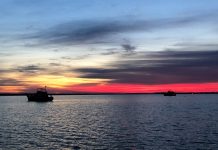
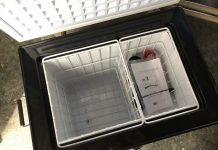









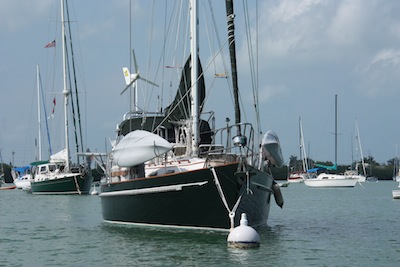

Good advise. Even as a sailor, I have mistaken sailboat anchor lights at the mast top for stars. We use LED anchor light at mast top plus a couple solar lights at deck level. More lights is better….
My interpretation of Rule 30 para. B is that you are required to place your anchor light in the position aboard where it is most visible, “…where it can best be seen…”.
This means that placing the light at a point lower than the mast top is actually a more faithful application of the rules, precisely because having the light on the top of the mast can and does cause it to be missed.
Here in Maine it’s common to see people using a separate anchor light clipped to the head-stay, and run half-way up the stay with a jib halyard.
So I think you’re doing it right!
I’ve read recently on the US Coast Guard site regarding anchor lights, that they must be a minimum of 3 meters off the water I believe, which is roughly 9 to 10 feel. I too have put an anchor light were you have, and I think it’s a good idea. I just purchased new LEDs from MarineBeam.com and I can’t wait to install them. I am going to put the new anchor light up on the top of the mast, and then I’m going to augment that with a light in the cockpit; two fold, I get an extra light reflecting off the surfaces in the cockpit, making the boat more visible as they’ll see the cockpit, not just a single light sticking up, not giving off any depth or location, But also thought that it might ward off unwanted visitors. I’m not worried about the light burning all night, as it too is an LED (Bibi electronics which I understand is no longer in business.) If you’re going to LEDs, I think you might want to look at marinebeam. What impressed me is they put a long cord right on the fixture, so once it mounted, and if you can get the connection below decks or at least waterproof, then they should last a really long time. That’s what I’m hoping anyway.
s/v Renasci